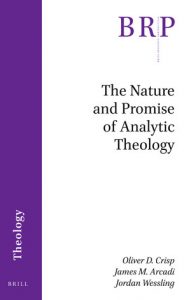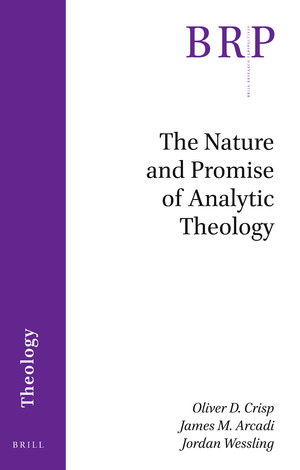Crisp, Oliver D., James M. Arcadi, and Jordan Wessling. The Nature and Promise of Analytic Theology. Leiden: Brill, 2019. vi + 104 pp. €70.00/$84.00.
Ever since the publication of the edited volume, Analytic Theology: News Essays in the Philosophy of Theology, which formally launched the analytic theology movement in 2009, questions and confusions remain as to what exactly analytic theology (AT) is. Not only do scholars from various disciplines take issue with the qualifier analytic in AT, a number of them doubt that AT can even be called theology (e.g., Martin Westerholm, “Analytic Theology and Contemporary Inquiry,” International Journal of Philosophy and Theology 80, no. 3 [2019]: 230–54). After ten years of various attempts at definition, Oliver Crisp as the co-founder of the movement, together with some of his A-Team, James Arcadi and Jordan Wessling, once again take up the task of restating and clarifying a definition in their The Nature and Promise of Analytic Theology. In writing this brief, yet substantive monograph, Crisp et al.’s ultimate aim is not simply to respond to some common misunderstandings to AT; rather they aim to highlight how AT has been operating and developing in the past and how it can contribute further to the task of theological construction today.
This monograph is structured around four sets of arguments that serve as cumulative cases for the legitimacy of AT and its benefits. Chapter 1 begins with further defense and clarification of the formal definition of AT given by Michael Rea in 2009 that has since become standard. In so doing, Crisp, Arcadi, and Wessling note the continuing significance of Rea’s paradigmatic prescriptions (P1–P5) of what minimally counts as the analytic style of AT (p. 5). Darren Sarisky (“Biblical Interpretation and Analytic Reflection,” Journal of Analytic Theology 6 [2018]: 164–65) provides a helpful summary of Rea’s P1–P5:
Analytic philosophers . . . seek to formulate their reasoning so that their core affirmations, or the skeletal outline of their case, could in principle enter into the structure of an argument that may be set out via formal logic; they prioritize precision of statement, transparency of meaning, and the logical coherence of all the beliefs under examination; they write with an austerity of style that eschews non-literal language unless it seems indispensable for making a point; they tend to break down complex concepts as much as possible, with the result that they are resolved into more rudimentary elements that are themselves clear and distinct; finally, they move by way of conceptual analysis toward proposals that can cope as well as possible with potential counterexamples.
While agreeing with Rea that AT minimally is defined as an approach to theology that uses the ambitions and style that are distinctive of analytic philosophy, Crisp, Arcadi, and Wessling propose that AT should also be understood as an intellectual culture. According to them the sociological qualifier, ‘intellectual culture,’ “helps explain why the nature of analytic theology is difficult to communicate to those who have not experienced firsthand the goals and ways of reasoning that permeate analytic approaches to doctrine” (p. 3). Such a qualifier not only requires an analytic theologian to be “bilingual” in the sense that one has to be able to speak fluently in the languages of analytic philosophy and theology (p. 12–13), but it elucidates partly why many non-analytic thinkers keep misunderstanding what analytic theologians are doing. Lastly, they suggest that AT additionally can be thought of as a “research program” with some common theological commitments that include “[1] some form of theological realism; [2] some claim about the truth-aptness, and truth-aimed nature of analytic theology; and [3] some claim about the importance of providing theological arguments for substantive doctrinal claims that reflect the sort of intellectual virtues and sensibilities prized by analytic theologians” (p. 15). These commitments, though certainly not shared by all analytic theologians, do highlight the theological nature more substantively rather than just the analytic style of AT.
In chapter 2, Crisp, Arcadi, and Wessling examine a fourteenth century method of doing theology that serves as a methodological antecedent for AT. In that medieval period, several theologians, including Durandus of St.-Pourçain, Peter Aureoli, Godfrey of Fontains, Gregory of Rimini, and Peter of Candia, operate with what was called as “declarative theology” (p. 20). Durandus, for example, defines declarative theology as “a lasting quality of the soul by means of which the faith and those things handed down in Sacred Scripture are defended and clarified by using principles that we know better” (p. 21). Moreover, following Aureoli, Crisp, Arcadi, and Wessling mention four functions of declarative theology that can benefit believers, for they might “(a) not understand the terms utilized in the articles, (b) come across defeaters to their belief in the articles, (c) lack examples or analogies, and (d) fail to have probable arguments to support their belief” (p. 25). Just like declarative theology, which uses philosophical reasoning to “imagine in a better and clearer way the things he believes,” AT is therefore “unique among methodologies on offer in contemporary Christian theology” (p. 33).
Chapter 3 follows the general thesis of chapter 2 in securing AT as a genuine species of systematic theology. Crisp, Arcadi, and Wessling select three contemporary theologians from various traditions, viz., John Webster, Brian Gerrish, and Gordon Kaufman, to demonstrate that, despite their differences as to what constitutes systematic theology, one can abstract from their work what Crisp and company call the “shared task” or the “conceptual threshold” for systematic theology (p. 38). Against critics who worry that AT is only philosophy or philosophy of religion in theology’s clothing, Crisp, Arcadi, and Wessling show that AT, at its best, has indeed been committed to the shared task of “explicating the conceptual content of the Christian tradition . . . using particular religious texts that are part of the Christian tradition, including sacred scripture, as well as human reason, reflection, and praxis (particularly religious practices), as sources for theological judgments” (p. 38). Moreover, AT cannot easily be dismissed as ersatz theology for deploying a distinct (analytic) philosophical method in addition to the shared task, “since all theologians use philosophical ideas, and very often align themselves with one or more philosophical tradition (Aristotelian, Platonic, existential, continental, hermeneutical, and so on)” (p. 42).
Admittedly, there might be some analytic theologians who would not follow closely the shared task closely, either by going too far in attempting to explain away all genuine mysteries of the Christian faith, or by relying too much on what Robert Jenson called “secularized theology” (p. 50). However, one should not overstate the case that all AT practitioners operate in a uniform manner. As argued in chapter 1, Crisp, Arcadi, and Wessling remind the theological community that AT as an intellectual culture is not “a bounded group where a perimeter is policed so that one is either ‘out’ or ‘in.’ Rather, it is something more like what might be termed a centered group, where we can see a cluster of members that are right at the heart of the movement, and others less central, or more peripheral, with others still further out with some connection, but without being entirely identified with the movement” (pp. 52–53). In short, not all analytic theologians are created equal, so it demands a case-by-case analysis before one judges AT as insufficiently theological.
The final chapter ends with the summary points from the previous arguments and further highlights the promise of AT as a “generative research program” (p. 57). The writers give examples of AT’s penchant of providing “theological models” in explicating core doctrines such as the Trinity and the incarnation, including recent developments in less popular ones like apophaticism, liturgy, the Eucharist, and more. Lastly, they note the ultimate appeal of AT: as an intellectual culture, it can indeed be “truly a global and ecumenical enterprise” (p. 67), even an interreligious one, though more work in areas of contextual or comparative AT are admittedly still in their infancy (p. 66). Notwithstanding, looking at how AT has been developing so far, I agree with Crisp, Arcadi, and Wessling that “it is perhaps not too bold to say that analytic theology represents one of the most significant developments in recent theological history” (p. 67).
In my estimation, therefore, this monograph succeeds in further clarifying what AT is and is not, and thus modestly promoting AT as an intellectual culture with a distinct, fruitful research program. By way of minor improvements, the authors could have included more thorough discussions (1) on the current state of the analytic/continental divide in philosophy, including how the two camps can work together to achieve the same theological goals, and (2) how AT can help theologians not only to “think God’s thoughts after him,” but also “to trace their unity” (i.e. the coherence between different loci in systematic theology) precisely because “God’s thoughts cannot be opposed to one another and thus necessarily from an organic unity” (Herman Bavinck, Reformed Dogmatics, 4 vols., ed. John Bolt, trans. John Vriend, [Grand Rapids: Baker Academic, 2003–2008], 1:44). Perhaps (2) also can serve as a link between the typically narrow foci of analytic philosophy and continental philosophy that tend to be “system-builders,” thus showing how both camps can and should cooperate in doing theology. With these two augmentations, I believe that this present work would further benefit many analytic and non-analytic thinkers alike in understanding AT, if not already.
Wilson Jeremiah
Trinity Evangelical Divinity School





